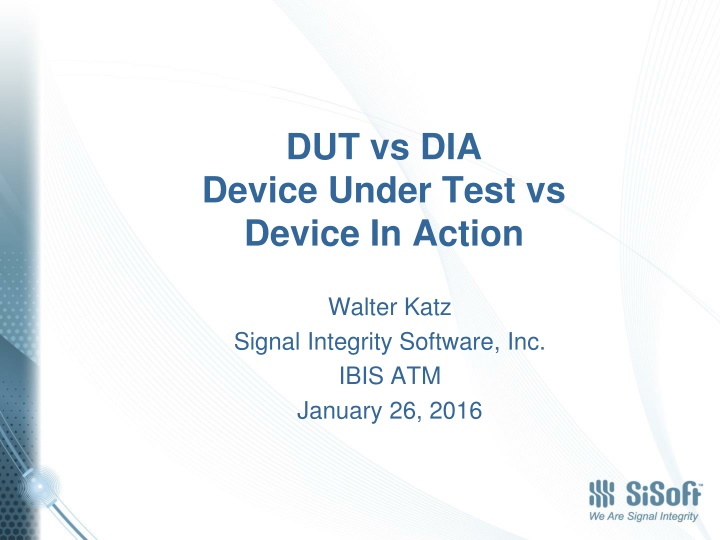
Device Under Test (DUT) vs. Device in Action - Signal Integrity Insights
Gain insights into the differences between Device Under Test (DUT) and Device in Action, and learn about measurement rules and suggested changes for IBIS models in signal integrity testing. Clarifications on test fixture references and component connections are also discussed.
Download Presentation

Please find below an Image/Link to download the presentation.
The content on the website is provided AS IS for your information and personal use only. It may not be sold, licensed, or shared on other websites without obtaining consent from the author. If you encounter any issues during the download, it is possible that the publisher has removed the file from their server.
You are allowed to download the files provided on this website for personal or commercial use, subject to the condition that they are used lawfully. All files are the property of their respective owners.
The content on the website is provided AS IS for your information and personal use only. It may not be sold, licensed, or shared on other websites without obtaining consent from the author.
E N D
Presentation Transcript
DUT vs DIA Device Under Test vs Device In Action Walter Katz Signal Integrity Software, Inc. IBIS ATM January 26, 2016
IBIS Describes DUT The DUT die shows all of the available power and ground pin reference voltage terminals. For many buffers, only one power pin and one common ground pin terminal are used. The absolute GND pin is the reference for the V_fixture voltage and the package model equivalent network. It can also serve as a reference for C_comp, unless C_comp is optionally split into component attached to the other reference voltages. 2
Device In Action All IBIS measurement rules used to evaluate the actual operation of a device in action in a complete system shall apply to the value of the voltage between the PAD and VSS terminals shown below. The ground terminal shall be used as a reference for C_comp, unless C_comp is optionally split into component attached to the other reference voltages. This is the unstated rule for the most common IBIS model that has just one power pin and one ground pin terminal. Rules for other cases need to be clearly defined. VDD PAD VSS 3
A Suggested Change The DUT die shows all of the available power and ground pin reference voltage terminals. For many buffers, only one power pin and one common ground pin terminal are used. The absolute GND pin is the reference for the V_fixture voltage and the package model equivalent network. It can also serve as a reference for C_comp, unless C_comp is optionally split into component attached to the other reference voltages. The DUT die shows all of the available power and ground pin reference voltage terminals. For [Model]s that do not specify [Pulldown Reference] or [GND Clamp Reference] then the reference for the V_fixture voltage shall be a ground pin for that [Model] under test as specified in the [Pin Mapping] section or a common ground pin. In this case, C_comp shall be connected to this ground pin or common ground pin. When [Pulldown Reference] or [GND Clamp Reference] is specified, then there is an DUT reference node generated by a circuit consisting of a resistor between this reference node and either [Pullup Reference] or [Power Clamp Reference] and a resistor between this reference node and either [Pulldown Reference] or [GND Clamp Reference] specified by new sub parameters R_DUT_puref, R_DUT_pcref, R_DUT_pdref and R_DUT_gcref. In this case, C_comp shall be connected to the [Pulldown Reference] pin if R_DUT_pdref is specified or the [GND Clamp Reference] pin if R_DUT_gcref is specified. 4
Conclusion IBIS rules used to describe measurement (or simulator) conditions required to make the Model sub parameters values should not be confused with how an IBIS model should be connected to the models of the system it is operating in. It is important to clearly define how IBIS models should be hooked up to models of the system it is connected to. Text is proposed to clarify test fixture reference for devices under test and how C_comp should be connected. 5
